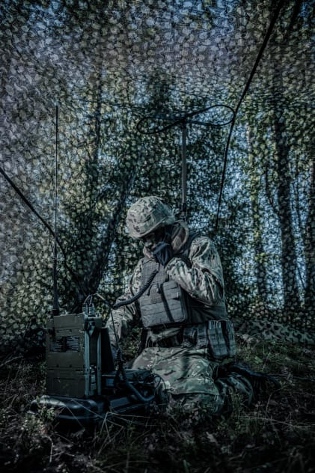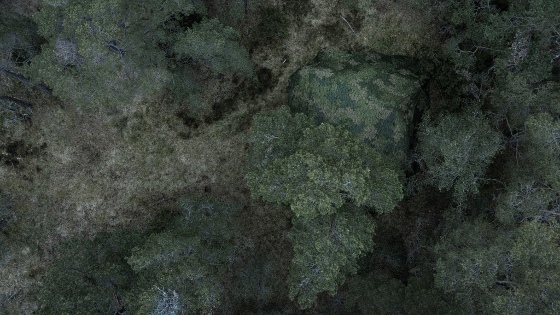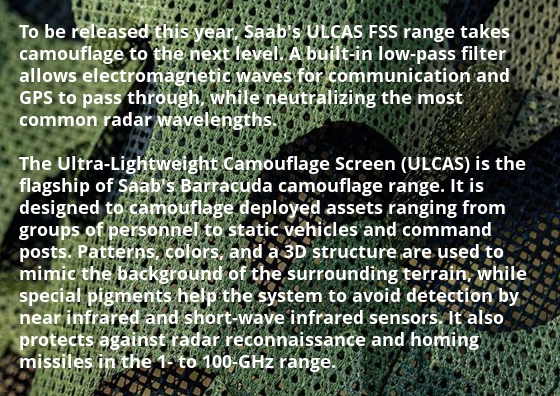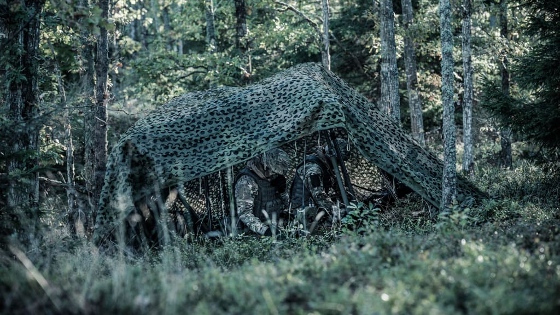 |
| September 19, 2023 | Volume 19 Issue 35 |
Designfax weekly eMagazine
Archives
Partners
Manufacturing Center
Product Spotlight
Modern Applications News
Metalworking Ideas For
Today's Job Shops
Tooling and Production
Strategies for large
metalworking plants
Military camouflage nets get key tactical upgrades
One major drawback of multispectral camouflage systems is that they neutralize not only enemy radar waves, but also useful radio and GPS signals. Now, Saab's business unit called Barracuda is rewriting the rule book with a camouflage system that manages hostile radar waves while allowing users full access to radio communication and GPS. Saab is based in Stockholm, Sweden.

Saab's Barracuda ULCAS camouflage screening with updated Frequency Selective Surface system shown from the inside. [Credit: Saab]
Ground, air, and satellite-based radar systems represent a major threat to deployed armed forces. By identifying radar-reflective objects, such as tanks, trucks, and aircraft, they deprive troops of both cover and the element of surprise.
Advanced camouflage solutions like Saab's Ultra-Lightweight Camouflage Screen (ULCAS) static nets can neutralize this threat thanks to materials that attenuate or weaken radar pulses. However, up until now, there has been one distinct drawback: The radar attenuating materials in multispectral nets not only neutralize radar waves but also the radio waves used for voice communication and GPS.
"If you are under a traditional multispectral net and you want to communicate using a radio, you generally need to place your antenna outside the net in order to get past the broad spectrum protection and to get a signal," says Dr. Johan Jersblad, a senior development engineer within Saab's business unit Barracuda. "In doing so, you are at risk of exposing yourself to the enemy, which is not ideal, particularly if you're doing forward reconnaissance. In the case of using GPS, you may need to place the entire GPS unit outside the net, and so you are even more exposed."

Can you spot Saab's Barracuda Ultra-Lightweight Camouflage Screen when it is deployed on the ground and viewed from a drone? [Credit: Saab]
Now, a game-changing innovation from Saab´s business unit Barracuda is about to radically alter the situation. Known as the Frequency Selective Surface system (FSS), the solution allows users of specially produced ULCAS nets to make full use of radio and GPS systems while remaining fully concealed.
VIDEO: Saab Barracuda's Ultra-Lightweight Camouflage Screen with the Frequency Selective Surface (ULCAS-FSS) feature represents the next stage in the evolution of advanced signature management technology, delivering an unprecedented degree of freedom when it comes to tactical communications. [Credit: Saab]
"Modern combat situations can evolve rapidly, and it's essential that deployed troops stay in touch," says Jersblad. "Meanwhile, GPS is vital for providing coordinates when you are coordinating air strikes from the ground. With the FSS system for our Barracuda ULCAS system, you can have full access to both these resources without reducing your level of signature management."
Lattice pattern is the key to the system
Jersblad explains the challenge with conventional multispectral nets is that enemy radar systems, radio communication, and GPS all rely on electromagnetic waves. The materials used to attenuate radar waves in conventional multispectral nets not only block common radar frequencies but a wide spectrum of radio waves.

"After an inquiry from a potential customer, we began exploring the potential for nets that focused on specifically absorbing the higher frequency electromagnetic waves used by radar systems rather than a broader spectrum," Jersblad says. "The result of this work is a camouflage system where the radar attenuating material is arranged in a lattice pattern. The size and shape of the pattern absorbs high-frequency radar waves but allows radio waves to pass easily through."
Internal network of experts
The ULCAS FSS net produced through this research closely resembles Saab's conventional ULCAS nets. "Looking at it, you can't spot the difference between an ULCAS net with the FSS and a regular one," says Jersblad. "They look and weigh the same and have the same visual and thermal properties. But there is a big difference in terms of being able to communicate without risking exposure."
The new nets represent a major step up from previous attempts to address the radio black-out problem. These include installing radio windows in the netting that were both inconvenient to use and negatively affected signature management.

Saab's updated ULCAS net as seen from ground level. [Credit: Saab]
Saab was at an advantage in developing the system thanks to its broad range of internal competences and wide-ranging knowledge of defense applications. For example, input was received by Saab engineers working with radomes -- protective covers for jet fighter radar systems that allow for the selective absorption of certain radar signals. "Experts from the radome team were able to help doing calculations and performing simulations to create the best pattern solution," says Jersblad.
Customers can have radar protection and communication
The FSS system is currently undergoing final testing with a goal of being released to the market by the end of 2023. Exhaustive field tests have already established its effectiveness at letting useful electromagnetic spectrums in while keeping out undesirable ones.
"The customers who have seen it already have been very impressed," says Jersblad. "One customer said they had left such a feature out of the specifications for their camouflage nets because they didn't think it was possible. Another customer said they had previously sacrificed radar protection in their camouflage so they could maintain their ability to communicate freely. With ULCAS FSS, they no longer have to choose one or the other."
While the initial application of the FSS system is to keep out radar signals while allowing radio waves to pass through, other outcomes can be achieved by changing the pattern design. "For example, by changing the pattern, we could keep communication radio waves out and let radar waves pass through," says Jersblad. "This might be useful if you have a radar operating under the net."
Learn more about Saab's camouflage systems at saab.com/products/land/camouflage-systems.
Source: Saab
Published September 2023
Rate this article
View our terms of use and privacy policy
